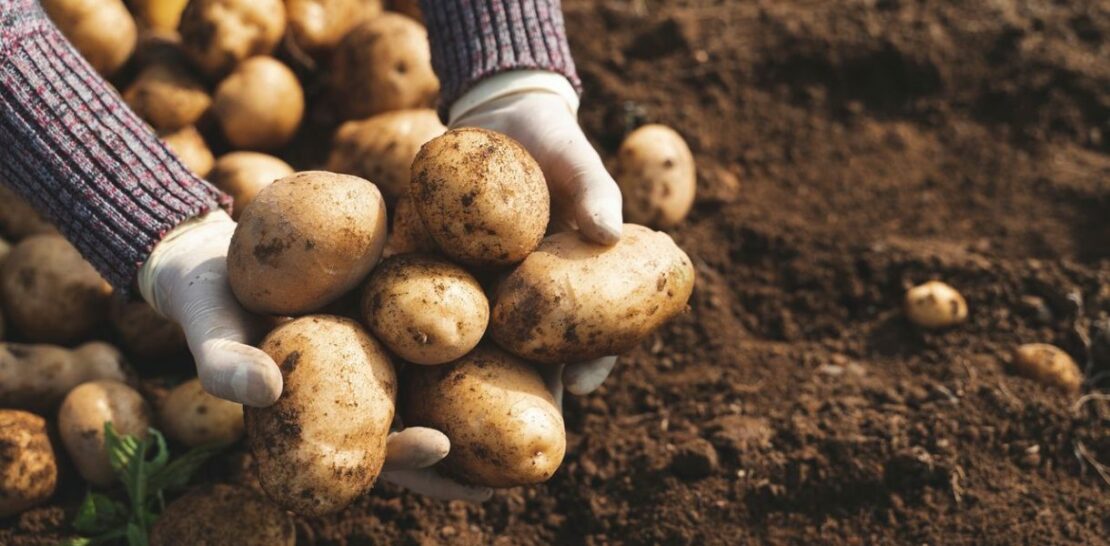For many, potatoes are a staple food in their daily diets, serving as a versatile and nutritious source of energy.
From classic baked potatoes to comforting mashed potatoes, and crispy French fries to hearty potato salads, this humble vegetable is both delicious and adaptable to various dishes.
As a result, growing potatoes at home can be an incredibly rewarding endeavor.
This comprehensive guide will provide you with all the information you need to successfully plant, grow, and harvest potatoes, ensuring that you can enjoy fresh, homegrown spuds all year round.
Understanding the Potato Plant: Fundamentals of Potato Biology and Varieties
Before diving into the process of growing potatoes, it is crucial to understand the basics of potato biology and the various types of potatoes available. This knowledge will enable you to select the right varieties for your climate and growing conditions, and help you make informed decisions throughout the cultivation process.
Potato Biology: The potato plant (Solanum tuberosum) is a member of the Solanaceae family, which also includes tomatoes, peppers, and eggplants. Potatoes are unique in that they grow underground from the plant’s swollen, modified stems called tubers. Unlike seeds, tubers contain a reserve of stored energy, allowing the potato plant to grow rapidly once the right environmental conditions are met.
Potato Varieties: Potatoes come in a wide range of shapes, sizes, colors, and flavors, and can be broadly categorized into three main types:
- Early Season Potatoes: These varieties mature quickly, often within 75 to 90 days, and are ideal for gardeners with shorter growing seasons. Examples include ‘Red Norland,’ ‘Irish Cobbler,’ and ‘Yukon Gold.’
- Maincrop Potatoes: Maturing in 90 to 110 days, maincrop potatoes are the most common type grown by home gardeners. They offer a larger yield and are suitable for long-term storage. Popular varieties include ‘Russet Burbank,’ ‘Kennebec,’ and ‘Desiree.’
- Late Season Potatoes: These potatoes require a longer growing season, typically 110 to 135 days, and are often grown for their unique flavors or specialized uses. Examples include ‘German Butterball,’ ‘Purple Majesty,’ and ‘All Blue.’
Starting with Seed Potatoes: Choosing, Preparing, and Planting Your Potato Tubers
Now that you have a better understanding of potato varieties, it’s time to acquire your seed potatoes and prepare them for planting. The process involves choosing healthy tubers, allowing them to sprout, and then planting them in the ground.
Choosing Seed Potatoes: When selecting seed potatoes, look for firm, disease-free tubers with a clean, unblemished appearance. Avoid potatoes with soft spots, wrinkled skin, or a musty odor, as these can be signs of decay or disease. You can purchase certified seed potatoes from a reputable garden center or online retailer, or save your own from a previous harvest. Be cautious about using store-bought potatoes, as they may have been treated with a sprout inhibitor that can affect their growth.
Preparing Seed Potatoes: About two weeks before planting, place your seed potatoes in a well-lit, cool room with a temperature of around 60°F (15°C) and high humidity. This process, known as chitting or greensprouting, encourages the development of short, sturdy sprouts. Once sprouted, cut larger seed potatoes into smaller pieces, ensuring that each piece has at least one sprout and a sufficient amount of flesh to sustain the plant’s initial growth. Smaller potatoes can be planted whole.
Planting Seed Potatoes: To plant your prepared seed potatoes, dig a trench about 4 to 6 inches (10 to 15 cm) deep in your garden, placing the tubers 12 to 15 inches (30 to 38 cm) apart. Ensure that the sprouts are facing upward, and then cover them with a couple of inches (5 cm) of soil. As the potato plants begin to grow, you will need to hill the soil around the plant, which will be discussed in a later section.
Providing Optimal Growing Conditions: Soil, Water, and Sunlight Requirements
Like all plants, potatoes have specific growing requirements that need to be met in order for themto thrive and produce a bountiful harvest. By understanding and providing the optimal soil conditions, water, and sunlight, you can increase the chances of a successful potato crop.
Soil Requirements: Potatoes prefer well-draining, loamy soil with a pH level between 5.0 and 6.0. Poorly draining soil can lead to rot and disease in the potato tubers, so it’s essential to ensure that the soil is adequately aerated and amended with organic matter, such as compost or well-rotted manure. Additionally, potatoes are heavy feeders, meaning they require a significant amount of nutrients to grow properly. Applying a balanced granular fertilizer or a slow-release organic fertilizer at planting time can help provide the necessary nutrients for your potato plants.
- Water Requirements: Potatoes need consistent moisture throughout the growing season, particularly during the period when the tubers are forming. Aim to provide approximately 1 to 2 inches (2.5 to 5 cm) of water per week, either through rainfall or supplemental irrigation. It’s essential to avoid overwatering or allowing the soil to dry out completely, as this can lead to irregularly shaped or cracked potatoes.
- Sunlight Requirements: Potato plants require full sun, which means they need at least 6 to 8 hours of direct sunlight per day. Ensure that your potato patch is located in an area of your garden that receives adequate sunlight, and be mindful of any structures or taller plants that may cast shade on your potato plants as they grow.
Caring for Your Potato Plants: Hilling, Pest Control, and Harvesting
Once your potato plants are established, ongoing care is required to ensure a healthy and productive crop. This involves hilling the soil around the plants, monitoring for pests and diseases, and knowing when and how to harvest your potatoes.
Hilling: As your potato plants grow, it’s essential to periodically mound soil around the base of the plants, a process known as hilling. This serves several purposes:
- It prevents the tubers from being exposed to sunlight, which can cause them to turn green and produce a toxic compound called solanine.
- It provides additional space for the tubers to grow and expand.
- It helps to smother weeds and conserve soil moisture.
Begin hilling when your potato plants are approximately 6 inches (15 cm) tall, and continue every few weeks throughout the growing season, being careful not to damage the developing tubers.
Pest Control: While potatoes tend to be fairly resilient, they can be susceptible to a number of pests and diseases. Some common potato pests include Colorado potato beetles, aphids, and wireworms, while diseases such as early blight, late blight, and scab can also affect potato plants. Regularly inspect your potato plants for signs of damage, and employ integrated pest management strategies, such as crop rotation, biological control, and the use of chemical pesticides when necessary.
Harvesting: Knowing when to harvest your potatoes is key to enjoying a delicious and well-timed crop. The precise timing will depend on the variety and your specific growing conditions, but some general guidelines include:
- Early Season Potatoes: Harvest when the plants are still green and actively growing, typically around 75 to 90 days after planting.
- Maincrop and Late Season Potatoes: Wait until the plants have died back and the foliage has turned yellow, which usually occurs 90 to 135 days after planting.
To harvest your potatoes, gently dig around the base of the plants with a garden fork, being careful not to pierce the tubers. Once harvested, allow the potatoes to cure in a cool, dark, and well-ventilated space for about two weeks to develop a thick skin and improve their storage quality. Store your cured potatoes in a cool, dark, and well-ventilated area, and enjoy your homegrown spuds throughout the year.
In conclusion, successfully growing potatoes requires an understanding of the potato plant’s biology and variety selection, careful preparation and planting of seed potatoes, providing optimal growing conditions, and ongoing care throughout the growing season. By following the guidance provided in this comprehensive guide, you can enjoy the satisfaction of harvesting your own delicious and nutritious potatoes to incorporate into your favorite dishes. Happy gardening!




